Japan: The Big Picture
The White House couldn’t receive a tsunami of mail, a big storm in the Pacific wouldn’t be a typhoon, no one would be the head honcho (hancho) and it couldn’t be a Sony without Japan. Here’s some basic information about the country.
Japan is in the northeast corner of Asia. If you look at a map or satellite image of Asia, you’ll see a big bulge on the right, like Santa’s stomach. Just above the top of the bulge, where it curves back to the left, there is what looks like a thumb giving the “thumbs down.” The thumb is pointing to Kyushu, the most southern and western of Japan’s four main islands, and so close to Korea that Sarah Palin could see it from here.

This is how Japan is represented on weather reports, and how many here think of it — as four main islands and, oh yeah, Okinawa. From the top, the four main islands are Hokkaido in purple, Honshu weighing in as largest and most populated in red, Shikoku in yellow, Kyushu in blue. Oh yeah, and Okinawa in green. Okinawa gets neglected in more ways than one as it is a group of islands, and was originally a separate country, “The Ryukyu Kingdom” that Japan colonized and which the U.S. kindly gave to Japan after occupying it following the war.
Most westerners are likely to know Sapporo on Hokkaido, famous for it’s snow festival. Honshu is the hostess with the mostest and hosts Tokyo, the capital and world’s largest city (37 million !) as well as Kyoto, one of the world’s great tourist destinations and cultural capitals, Osaka, which many of you saw in the movie Black Rain, and Hiroshima, victim of the first atomic bomb. I doubt people outside Japan would know anyplace on Shikoku, but it’s famous here as the setting of one of the most famous novels (Botchan) and for a Buddhist pilgrimage route to eighty-eight temples. Kyushu, where Japan Eight is located, has Nagasaki, victim of the second (and let’s hope last) atomic bomb and the setting of Madame Butterfly.
The country rests on four tectonic plates, which got it off to a shaky start, and is full of volcanic mountains, natural hot springs, and the world’s largest active caldera at Mt. Aso, on Kyushu. Being no larger than California, and with about seventy percent of the landmass mountains and ninety percent of the people in cities, one of the most important descriptors is densely populated, a.k.a. really crowded. This is crucial to the culture. About a fifth of the land is arable, and lots of that is rice, so from ancient times the sea has been a major source of food (though some westerners might not think of it as such) and Japan is now probably the world leader in aquaculture and the most voracious fisher. Tsukiji, in Tokyo, has the distinction of being the world’s largest fish market.
… be sure to tune in for Japan: The Big Picture part 2



Comments